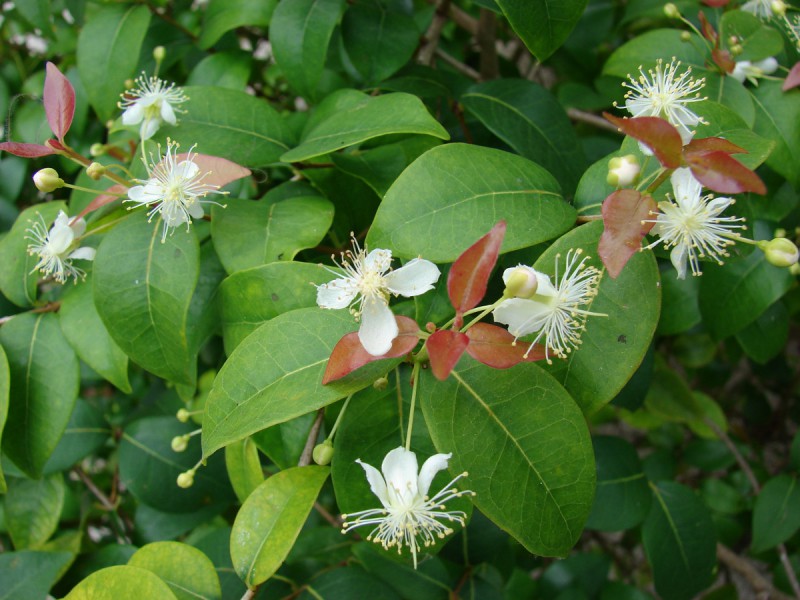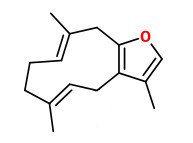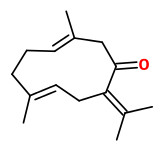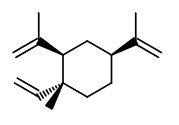Dies ist eine alte Version des Dokuments!
Eugenia uniflora L. - syn.Myrtus brasiliana L.; Eugenia michelii Lam. - Myrtaceae
pitanga, Surinam cherry, Brazil-cherry, Surinamkirsche, Pitanga, Kirschmyrte
Evergreen shrub or small tree, native to South America, cultivated and naturalized in Central America, South Africa and Australia. http://www.ars-grin.gov/cgi-bin/npgs/html/taxon.pl?16210
„Fruit: The taste ranges from sweet to sour, depending on the cultivar and level of ripeness (the darker red to black range is quite sweet, while the green to orange range is strikingly tart). Its predominant food use is as a flavoring and base for jams and jellies. The fruit is high in vitamin C and a source of vitamin A.
The leaves are spread on house floors in Brazil, so that when crushed underfoot, they exude a smell which repels flies.“ https://en.wikipedia.org/wiki/Eugenia_uniflora
„There are 2 distinct types: the common bright-red and the rarer dark-crimson to nearly black, which tends to be sweeter and less resinous… The fruits should be picked only when they are so ripe as to fall into the hand at the lightest touch, otherwise they will be undesirably resinous. Gathering must be done daily or even twice a day… The seeds are extremely resinous and should not be eaten. Diarrhea has occurred in dogs that have been fed the whole fruits by children. The strong, spicy emanation from bushes being pruned irritates the respiratory passages of sensitive persons.
Other Uses: The leaves have been spread over the floors of Brazilian homes. When walked upon, they release their pungent oil which repels flies. The bark contains 20 to 28.5% tannin and can be used for treating leather. The flowers are a rich source of pollen for honeybees but yield little or no nectar.
Medicinal Uses: In Brazil the leaf infusion is taken as a stomachic, febrifuge and astringent. In Surinam, the leaf decoction is drunk as a cold remedy and, in combination with lemongrass, as a febrifuge. The leaves yield essential oil containing citronellal, geranyl acetate, geraniol, cineole, terpinene, sesquiterpenes and polyterpenes.“
[Julia F. Morton: Fruits of warm climates, Florida, 1987: Surinam Cherry, S. 386–388]
http://www.hort.purdue.edu/newcrop/morton/surinam_cherry.html
Nigerian E. uniflora leaves yielded 1% of essential oil after 5 hours of steam distillation and consisted mainly of furanodiene and furanoelemene, selina-1,3,7(11)-trien-8-one and oxidoselina-1,3,7(11)-trien-8-one.
[Volatile constituents of Eugenia uniflora leaf oil., Weyerstahl, P., Marschall-Weyerstahl, H., Christiansen, C., Oguntimein, B. O., Adeoye, A. O.,Planta medica, Vol.54(6), 1988, 546]
„The leaf oil of Eugenia uniflora L. [syn. Stenocalyx michelii (Berg.) Legrand] was investigated by GC/MS, retention data, and 13C-NMR spectroscopy. The main constituents were selina-1,3,7(11)-trien-8-one (48.52%) and oxidoselina-1,3,7(11)-trien-8-one (17.33%).“
[Volatile constituents of Eugenia uniflora leaf oil from Northeastern Brazil., de Morais, S. M., Craveiro, A. A., Machado, M. I. L., Alencar, J. W., Matos, F. J. A., Journal of Essential Oil Research, 8(4), 1996, 449-451]
„Extracts from pitanga leaves are considered to be effective against many diseases, and are therefore used in popular Brazilian medicines. In this study, the volatile constituents of pitanga fruits (Eugenia uniflora L.) were trapped on to Porapak-Q and eluted with ethyl acetate, and the chemical composition of the extract was analyzed by gas chromatography and gas chromatography/mass spectrometry. Fifty-four compounds were detected, and twenty-nine of those were identified by close matches with standard MS spectra. Monoterpenes (75.3% in mass) were found to comprise the largest class of the pitanga fruit volatiles, including trans-β-ocimene (36.2%), cis-ocimene (13.4%), the isomeric β-ocimene (15.4%) and β-pinene (10.3%). Several known therapeutic constituents of pitanga leaf extract, such as selina-1,3,7(11)-trien-8-one (the major constituent) were also found to be present in the fruit volatile extract, suggesting that the fruit may display therapeutic properties similar to those of the leaf extract.“
[Volatile compounds from pitanga fruit (Eugenia uniflora L.)., Oliveira, A. L., Lopes, R. B., Cabral, F. A., Eberlin, M. N., Food chemistry, 99(1), 2006, 1-5]
„The leaf essential oil of Eugenia uniflora L. (Myrtaceae) was extracted by Clevenger apparatus and analysed by gas chromatography-mass spectrometry (GC-MS). The leaves were collected and immediately extracted for five consecutive days at 9:00 am and 2:00 pm. No variance in the oil yields were observed in the period. Furanodiene and its rearrangement product, furanoelemene (or curzerene, 50.2%), β-elemene (5.9%) and α-cadinol (4.7%) were identified as the most abundant compounds.
GC-O-AEDA pointed to nine active aroma compounds: β-elemene (5.9%, FD 256, fresh lemony and peppery), γ-elemene (3.5%, FD 4, green and oily), spathulenol (3.8%, FD 2, woody), globulol (3.1%, FD 2, woody), viridiflorol (1.7%, FD 2, woody), α-cadinol (4.7%, FD 4, woody), atractylone (1.8%, FD 2, green, floral), (E,E)-germacrone (1.0%, FD 256, woody and perfume like note resembling pitanga’s leaf) and also furanodiene and furanoelemene (together 50.2%, FD 1024), the most intense aroma-active compound due to its higher flavor-dilution factor. The literature olfatory descriptions for furanodiene are spicy, woody, mushroom-like and for furanoelemene green, woody and geranium. In the present study, the co-elution of these compounds gave a spicy and woody aroma which resembles pitanga.
The compound selina-1,3,7(11)-trien-8-one, pointed by Weyerstahl as one of the most important compound in the aroma of E. uniflora was not observed, even after co-injection of an authentic sample and single ion monitoring (SIM) GC-MS analyses. Equally, the compound oxidoselina-1,3,7(11)-trien-8-one was not detected in this leaf essential oil.“
[Identification of impact aroma compounds in Eugenia uniflora L.(Brazilian Pitanga) leaf essential oil., Melo, R. M., Corrêa, V. F., Amorim, A. C. L., Miranda, A. L. P., Rezende, C. M., Journal of the Brazilian Chemical Society, Vol.18(1), 2007, 179-183]
http://www.scielo.br/scielo.php?pid=s0103-50532007000100020&script=sci_arttext

Eugenia uniflora (flowers and young red leaves). Location: Midway Atoll
CC BY-SA 3.0, Author: Forest & Kim Starr Wikimedia Commons




